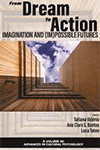
From Dream to Action
Imagination and (Im)Possible Futures
Edited by:
Tatiana Valério
Ana Clara S. Bastos
Luca Tateo, University of Oslo (Norway) and Federal University of Bahia (Brazil)
A volume in the series: Advances in Cultural Psychology: Constructing Human Development. Editor(s): Jaan Valsiner, Niels Bohr Professor of Cultural Psychology, Aalborg University.
Published 2021
The ubiquitous presence of imaginative work points at its importance among the higher mental functions. This collective volume discusses both the social relevance of imagination, that cannot be reduced to an inter-individual feature, and the cultural-historical conditions of imagining. The authors develop different theoretical and empirical works in which imagining, planning, anticipating, remembering and acting are put in relation with crucial moments of human existence, as early as birth and even after death. The proposal of this volume emerged during a “kitchen seminar” session at the III International Seminar of Cultural Psychology in Salvador da Bahia (Brazil, 2017). The debate revolved around the imaginative capability of human beings and the possibilities to investigate this phenomenon in a new key. The awareness that an innovative theoretical and empirical contribution was needed to the understanding of imaginative phenomena in everyday life led to the proposal of the book From Dream to Action: Imagination and (Im)Possible Futures. The book aims to talk to different audiences: psychologists, sociologists, artists, teachers and healthcare professionals, addressing a variety of life experiences - such as imagining alternative futures when facing a terminal illness, an adoption, a transplant waiting list, or the choice to give up your musical instrument - mobilize multiple dimensions of human psyche, from the basic emotions to the more sophisticated higher mental functions. The constant effort is to understand the psychological and sociocultural dynamics of each event, and to contribute to the understanding of human imagining in the area of semiotic-cultural psychology, dialoguing with contributions from all the human and social sciences.
CONTENTS
Series Editor’s Preface: The Irresistible Desire Towards Imagination, Jaan Valsiner. Introduction: Towards a General Study of Imaginative Processes in Human Purposeful Action, Luca Tateo, Tatiana Valério, and Ana Clara S. Bastos. SECTION I: WHAT ABOUT IMAGINATION? The Imaginative in the Concrete: How Action is Premised on Emerging Hopes and Potentiality, Stephan S. Sieland and Niklas A. Chimirri. The Future of Individuals: Uncertainty, Action, and Non-Action, Emiliana Mangone. SECTION II: HEALTH CARE AND IMAGINATION. The Dimension of Temporality in Rare Disease Stories: Towards a Possible Future? Altomare E. Zagaria, Giuseppina Marsico, R. Scardigno, and Giuseppe Mininni. Imagined Future in the Life Course of a Heart Transplant Patient: Anhanga, the Dog Protector, Nathaly Maria Ferreira-Novaes, Maria C. D. P. Lyra, Mariana Bentzen Aguiar, Janicleide Nascimento de Souza, and César Filipe da Silva Oliveira. Imaginative Processes About the Future for Young Adults With Chronic Kidney Disease, Agnaldo Junior Santana Lima and Marilena Ristum. Imagination and Mourning: The Case of a Young Caregiver, Brena Carvalho, Ana Clara Bastos, Alane Leite, Marilena Ristum, Julianin Araujo, and Leonardo Lima. SECTION III: ART AND IMAGINATION. Changing-and-Returning to a Musical Instrument: Exploring Dilemmatic Experiences in the Trajectory of a Brazilian Percussionist, Elsa de Mattos, Tatiana Valério, and Bernardina S. A. de Sousa. Unfreezing Social Representations Through Imagination in Open Society: Enabling Movement and Human Encounters Beyond Borders, Dany Boulanger. Imagining the Future in a Transnational Adoption Process, Pirkko Raudaskoski. SECTION IV: DREAMING. Dream Movements of Flight and Fall, Line Joranger. Quieting Disquieting Experience: Using Dreams, Diaries, and Imagination to Overcome Symbolic Ruptures, Emily Abbey and Katherine Talian. Dreaming Uncertainties: A Semiotic Interpretation of Bion’s “Negative Capability” Condition for Imagination Emerging, Raffaele De Luca Picione. SECTION V: EDUCATION AND IMAGINATION. Imagination and Argumentation: Exploring Potential Alternatives as a Reflective Tool for Educational Context, Gabriel Fortes Macêdo. A “Box of Surprises”: Imagination and the Challenge of Practicing Psychology, Karina Moutinho, Taciana Feitosa de Melo Breckenfeld, and Candy E. M. Laurendon. About the Authors.
-
Paperback978-1-64802-279-1
Web price: $45.04 (Reg. 52.99)
-
Hardcover978-1-64802-280-7
Web price: $80.74 (Reg. 94.99)
- eBook978-1-64802-281-4

- PSY031000 - PSYCHOLOGY: Social Psychology
- PSY044000 - PSYCHOLOGY: DEVELOPMENTAL: Lifespan Development
- PSY017000 - PSYCHOLOGY: Interpersonal Relations
-
 Cultural Psychology of Intervention in the Globalized World
Cultural Psychology of Intervention in the Globalized World
-
 Culture, Work and Psychology
Invitations to Dialogue
Culture, Work and Psychology
Invitations to Dialogue
-
 Deep Loyalties
Values in Military Lives
Deep Loyalties
Values in Military Lives
-
 Drama of Multilingualism
Literature Review and Liberation
Drama of Multilingualism
Literature Review and Liberation
-
 Home in Transition
The Cultural Construction of Heimat
Home in Transition
The Cultural Construction of Heimat
-
 Making of Distinctions
Towards a Social Science of Inclusive Oppositions
Making of Distinctions
Towards a Social Science of Inclusive Oppositions
-
 Ornamented Lives
Ornamented Lives

